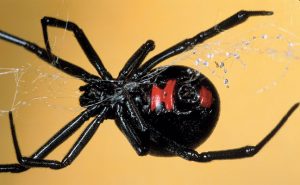Author’s Note: Information is taken from Truman’s Scientific Guide to Pest Management Operations, available online at the PMP Bookstore.
Spiders are not insects, and the easiest way to tell that is their eight legs instead of six. But these arachnids also lack wings, antennae, and have only two major regions: a carapace (cephalothorax), which includes the fused head and thorax, and an abdomen.
Truman’s puts spiders in the “Occasional Invaders” chapter, and discusses several species in depth, including:
- Agarian sac spider, Cheiracanthium inclusum / Yellow sac spider, C. mildei.
- Black widow spider, Latrodectus mactans and L. hesperus.
- Brown recluse spider, Loxosceles reclusa.
- Hobo/Aggressive house spider, Eratigena agrestis.
-
An agrarian or yellow sac spider, Cheiracanthium spp.
These small- to medium-size spiders are typically found in living spaces, basements, garages or around patios of homes.
Photo: Tom Myers
-
A black widow spider.
Note the distinctive red hourglass-shaped marking on the underside of the abdomen, against an overall black color.
Photo: Tom Myers
-
A brown recluse spider.
Note the characteristic fiddle-shaped marking on top of its cephalothorax, and visible fangs. At full size, this species is 1 to 1.5 in. across when viewed from above.
Photo: Dr. Gerald Wegner
Spider management
Personal protective equipment (PPE) such as wearing long sleeves tucked into gloves, a jacket or sweatshirt with a hood, and pant legs tucked into boots, are all recommended precautions, especially when dealing with venomous species. Rubber bands or masking tape can be used over pant legs and sleeves, or over boots and gloves, to prevent critters from crawling up onto skin. Shake out any clothing and items stored in spider-infested areas.
Control measures can include, as appropriate:
- Sanitation: Remove clutter (spider harborage) and vacuum/knock down any adult spiders, webbing and egg sacs. This goes for both indoors and around the outdoor perimeter.
- Space treatment: Appropriately labeled synergized pyrethrins and other non-residual pyrethroids can be useful for cleanouts.
- Residual treatment: There are two scenarios where an appropriately labeled residual can be useful:
- If the spider population is heavily established indoors.
- If an outdoor species in migrating indoors. All areas where the spiders have been found should be treated, especially dark corners.
- Light management: Reducing the night lighting, especially around commercial accounts, can reduce the amount of insects — and thus the food source of spiders.
Spiders in the news
Cornell University researchers have discovered that jumping spiders can “hear” (with hairs on their legs) when a human enters a room.




Leave A Comment